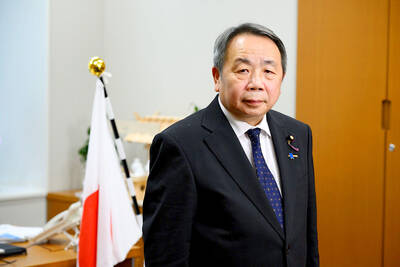Coffee consumption nationwide is continuing to grow, figures on the annual import of coffee beans indicate, with statistics showing that Taiwan’s coffee market continues to thrive, observers of the coffee sector have said.
Ministry of Finance import statistics showed raw coffee beans, roasted coffee beans and ground coffee, as well as various products utilizing coffee, amounted to 7,990 tonnes in 1997, and had risen to 25,085 tonnes by 2010 — a three-fold increase within 13 years.
The import value of coffee products rose from US$44.6 million in 1997 to US$199 million in 2010, which marked a new record in Taiwanese coffee import history.
Working on the estimation that an average of 10g of coffee beans are used to make one cup of coffee, the overall figures for coffee consumption across Taiwan in 2004 stood at 1 billion cups of made-on-the-spot coffee, with an average of about 47 cups of ready-made coffee being consumed per head of the population nationwide per year.
The figures have since leaped to 1.7 billion cups of made-on-the-spot coffee in 2010, which means that an average of 78 cups of coffee are being consumed by every person in the nation per year.
According to industry observers monitoring the coffee sector in Taiwan, before 1990, the majority of coffee shops were personally owned and operated. However, after the Japanese firm Doutor established itself in the Taiwanese market — becoming the first coffee chain in Taiwan — others followed suit.
Another Japanese company, Kohikan, as well as local coffee chains Dante and Ikari, have also made a splash in the local market with their “NT$35 cup” proving a popular sales device.
Observers tend to cite 1998 as a watershed in the development of the Taiwanese coffee industry, when the Uni-President company introduced the US coffee chain Starbucks, which paved the way for other medium-to-high-priced coffee chains, including IS Coffee, Barista Coffee and Mr Brown Coffee.
In 2002, the appearance of ecoffee, which offered common-priced coffee, as well as take-outs and deliveries, shook up the coffee industry and at its peak, the firm was boasting sales of 20 million cups of coffee annually.
The emergence of the 85°C chain the following year provided another opportunity for coffee investors by combining affordably priced coffee along with affordably priced cakes and pastries; at its peak it was selling over 40 million cups of coffee a year.
Competition in the low-priced coffee market began to heat up when the convenience store chain 7-Eleven, also owned by Uni-President Co, made its market debut. Within a few years, 7-Eleven’s City Cafe operation became the store’s most profitable line, churning out 100 million cups of coffee per year and generating revenue of NT$500 million (US$17 million). Coffee sales now represent 7-Eleven’s highest yield product per ping (3.3m2).
With Hi-Life, OK and Family Mart convenience stores taking their cue from 7-Eleven and venturing into the coffee market as well, observers of the sector conservatively estimate that at least 200 million cups of coffee are served at the four chains combined.
Observers say there is still room for growth for convenience stores and certain Chinese restaurants to target the coffee-drinking market.

A strong continental cold air mass is to bring pollutants to Taiwan from tomorrow, the Ministry of Environment said today, as it issued an “orange” air quality alert for most of the country. All of Taiwan except for Hualien and Taitung counties is to be under an “orange” air quality alert tomorrow, indicating air quality that is unhealthy for sensitive groups. In China, areas from Shandong to Shanghai have been enveloped in haze since Saturday, the ministry said in a news release. Yesterday, hourly concentrations of PM2.5 in these areas ranged from 65 to 160 micrograms per cubic meter (mg/m³), and pollutants were

Taiwan’s armed forces have established response protocols for a wide range of sudden contingencies, including the “Wan Chun Plan” to protect the head of state, the Ministry of Defense (MND) said today. After US President Donald Trump on Saturday launched a series of airstrikes in Venezuela and kidnapped Venezuelan President Nicolas Maduro, concerns have been raised as to whether China would launch a similar “decapitation strike” on Taiwan. The armed forces regularly coordinate with relevant agencies and practice drills to ensure preparedness for a wide range of scenarios, Vice Minister of National Defense Hsu Szu-chien (徐斯儉) told reporters before a

EVA Airways on Saturday said that it had suspended a pilot and opened an investigation after he allegedly lost his temper and punched the first officer several times as their plane was taxiing before takeoff at Los Angeles International Airport. According to a report published on Thursday by The Reporter, the incident occurred after the flight’s Malaysian first officer tried to warn the Taiwanese pilot, surnamed Wen (文), that he was taxiing faster than the speed limit of 30 knots (55.6kph). After alerting the pilot several times without response, the first officer manually applied the brakes in accordance with standard operating

Japanese Councilor Hei Seki (石平) on Wednesday said that he plans to visit Taiwan, saying that would “prove that Taiwan is an independent country and does not belong to China.” Seki, a member of the Japan Innovation Party, was born in Chengdu in China’s Sichuan Province and became a naturalized Japanese in 2007. He was elected to the House of Concilors last year. His views on the Chinese Communist Party (CCP) — espoused in a series of books on politics and history — prompted Beijing to sanction him, including barring Seki from traveling to China. Seki wrote on X that he intends